Tag: Rod and Ring
My Experiences with Rod and Ring parts 1 and 2 (Threshold and Foundation)
I finally got around to making videos of my experiences with the Threshold and Foundation sections of Rod and Ring. These videos are pretty brief. I’ve already shared more about the Foundation rituals earlier in this blog. (I don’t think I did blog posts about Threshold. That might have been before I started writing openly about my spiritual explorations).
My Experience with Rod and Ring – Part 3: Descent
I recently finished the third part of Descent in Rod and Ring and will be beginning Ascent this week! Here is a video I made talking about my experiences working through the Descent rituals. I’m planning on going back to do videos on the Foundation and Threshold sections, which I did before I started making videos. Hopefully before I finish the last parts of my initiation in September.
Rod and Ring – Descent: House of Dust
I did the last Descent ritual from Rod and Ring in July, right after returning home from an amazing cruise vacation. I’ll try to remember to make a separate blog post about that! It was a month ago, and I still haven’t even gone through all of my photos and videos yet! I did spend a lot of time on my vacation reflecting on my spiritual journey and my relationship with the gods in preparation for the ritual. As always, I set up a travel shrine on my nightstand in the cabin.
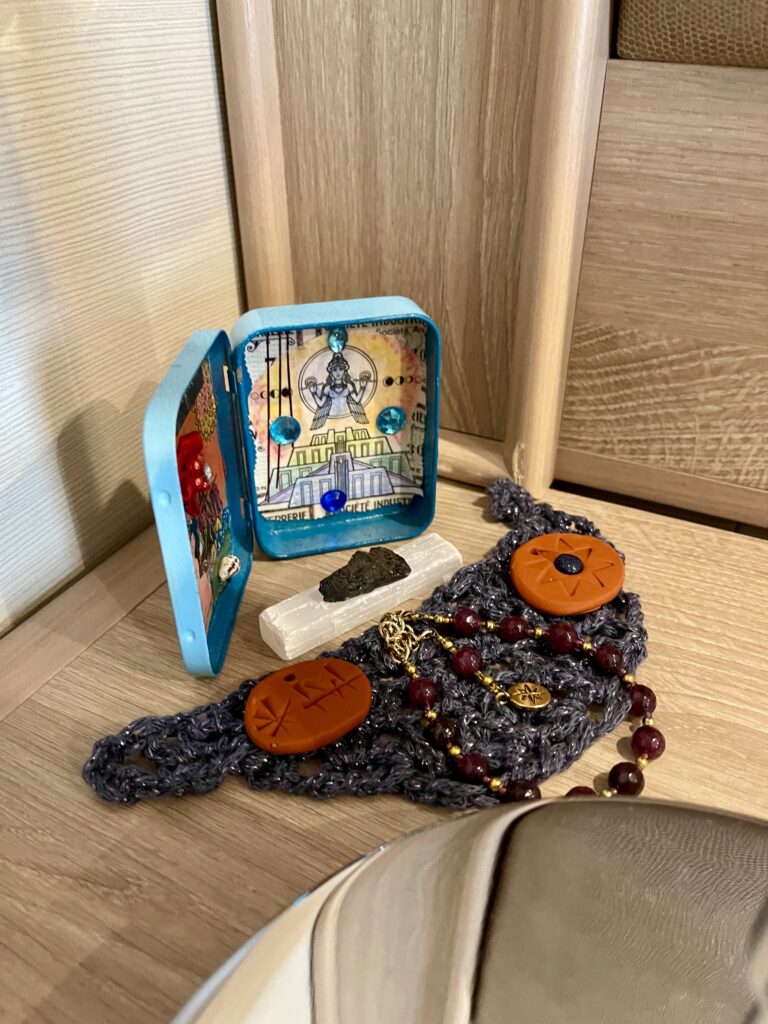
But this post is about my ritual work.
In House of Dust, the supplicant comes face to face with the deities of the underworld after having already crossed the river Hubur and descended past the seven gates. It begins with reflecting upon the seven gifts from the gods that you received in Foundation and have given up in the previous Descent rituals.
I spent some time in meditation reflecting on how these gifts relate to experiences in my own life and what it means to give them up. I’m not going to spend a lot of time talking about that here, as it is a personal experience for everyone.
Then I had to vow to return to the underworld at my appointed time when the gods decree. I took this to mean that I am vowing to accept my mortality when it is time. I shouldn’t try to fight the inevitable. I will return to the underworld to stand before Ereshkigal and the other underworld powers, and not try to hold onto the world of the living as a ghost or whatever.
After completing the ritual and taking my leave from the underworld, I still had to send a replacement to take my place in the underworld. For this, I had to make a clay effigy, which I ritually brought to life with the Bringing Clay to Life ritual. This was based on the mythology that the gods created humans from clay mixed with their own blood. I used air dry clay made from natural ingredients so that it wouldn’t harm the environment and I buried it in the critter grave yard area of my garden. It had to be buried in a cemetery if possible. I consider this to technically be a cemetery, and it is a location that I can tend to every day to add more incense and flowers. I did my whole funerary ritual for this effigy and continued burning incense there for a week, and occasionally after.
In preparation of the temple dedication ceremony I’ll be doing as part of the Ascent portion of my initiation in September, I am rebuilding my shrines to honor all of the deities I have encountered on this journey. I already had a shrine to Ereshkigal, but I added a tablet with the names of all seven of the powers of the underworld. I also made a special icon for Gula since I do find myself praying to Her a lot. For Gula, who is a goddess of medicine and healing, and is associated with dogs, I made a clay dog with her name inscribed and a spot to hold this old-timey medicine bottle I found while digging in my garden a few years ago. (I also made similar icons for all of the deities of the Earth using items that represent Them. I’ll show them in a future post and/or video).
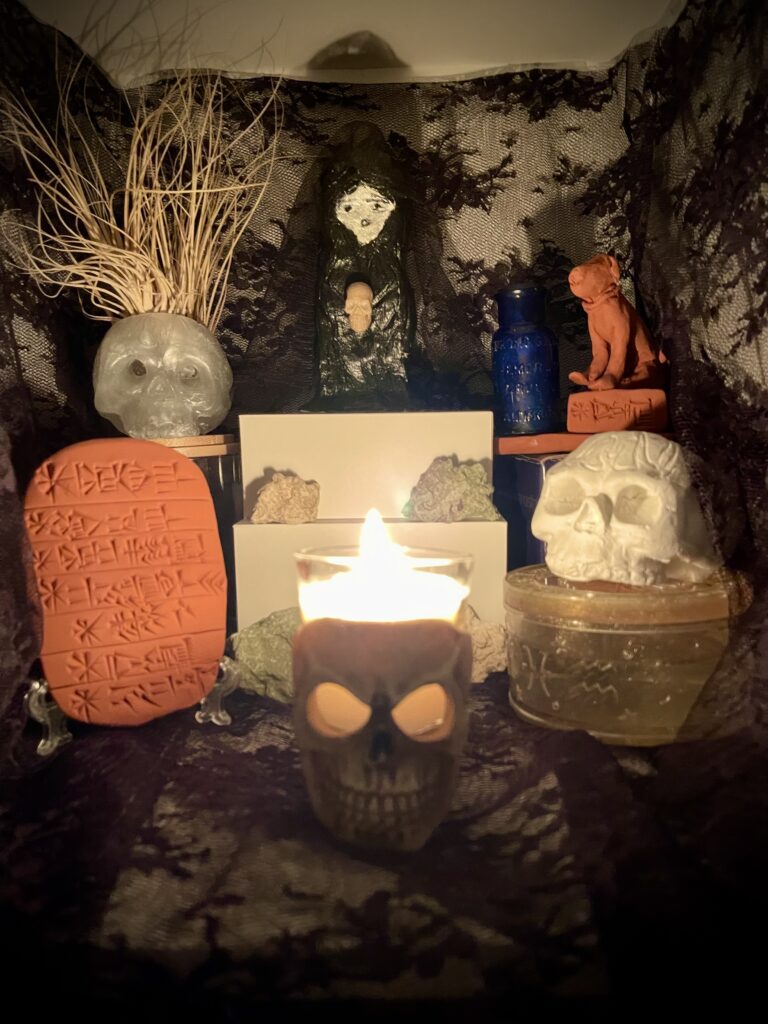
Rod and Ring: An Initiation Into a Mesopotamian Mystery Tradition – An Overview of My Experience
I know I’ve written a bit about my experiences working through Rod and Ring here, but I wanted to talk about it a bit on my YouTube channel as well. This video is an over view of the initiatory journey and a little bit about some of my experiences going down this path.
Rod and Ring – Descent: The 7 Gates
This month I did the second part of the descent rituals for Rod and Ring. Technically I did it a day earlier than I was supposed to because I wanted to see what would happen if I did it on the night of the solar eclipse. And I think I made the right choice for me. I think adding that energy into my ritual gave it a bit of extra power. To me, the moon eclipsing the sun kind of represents the hidden mysteries coming to the forefront over what is normally revealed in every day life. So it seemed like a good time to do work relating to the underworld.
At the first gate, I had to relinquish my light/fire. The book didn’t give any actual physical actions to symbolize this, but in the moment I felt like I was supposed to extinguish the candle on my altar that I use to represent myself (or sometimes mortality in general – it’s in a pink skull candle holder), so I did that. I set up my altar the same way I do for my daily devotional and magickal workings, and just add whatever else I need for the Rod and Ring work, so I already had it burning.
Then, for each of the rest of the gates, I felt like I had to give up something physical as well, so I removed the pieces of jewelry that I thought best corresponded with each gate. Except for gate six, in which I had to give up my “song,” so I turned off the background music I was using and did the rest of the ritual with no sounds except the ritual words. I don’t read the actual ritual text ahead of time because I like it to be as immersive as possible, but if I had, I think I would have prepared the items to “give up” a little bit better. Though I guess it might have been better this way, not knowing ahead of time that I would be physically removing things (though I’ve read the descent myth a billion times, so it really shouldn’t have been a surprise).
I stopped to meditate on each gate for quite a while before proceeding to the next. After the ritual, I stayed at my altar in meditation for a while and I think I did pass out for a bit, and then I got really sick and threw up. I’m only documenting that so if anyone is thinking about starting this journey, you’ll be aware of how it can affect you physically. It’s probably not a journey for everyone to undertake, but I’m glad I’m doing it.
The book said to do each of the underworld sections three months apart, but I was talking to Prisca, the priestess who runs Circle of Inanna, and she said that Samuel David said it was ok to do the three rituals over three months total. The last couple days, I’ve been thinking over if I want to keep my House of Dust ritual three months after the 7 Gates, or just do it on the next new moon. I think I’m going to keep it for July as I had originally planned. I have two reasons for this:
First, I’m going to be exploring some caves just before I have this ritual planned, and I think keeping the sensory memory from that experience fresh in my mind will add an extra dimension to the ritual. Kind of like how I used my time at Kalahari in the first part of Descent back in January when I crossed the river.
Second, keeping it scheduled how I have it planned mirrors my cancer treatment journey from a couple years ago, which began in January and ended in July. And I think an intentional journey through the underworld that mirrors the same time frame is going a long way in helping me to integrate and come to terms with that very much unwanted “underworld” experience.
I know some Mesopotamian polytheists have a problem with interpreting the myths in a psychological way like that, but myths are first and foremost stories – the oldest stories – and stories are meant to be interpreted in many different ways. There’s no one “correct” interpretation or one “correct” way to work with any particular myth. In some of my classes for my English/Creative Writing degree, we were expected to read and analyze stories from many different perspectives. Of course 5000 year old myths can be approached from many, many, many different perspectives! Maybe some of the more mainstream modern religions like Christianity take a mythic literalist approach where they believe each of their biblical myths literally happened and can mean only one thing, but I feel like that is nonsensical and would miss the point of paganism entirely. That’s just not how literature works! And in my opinion, myths in particular are humans’ interpretations of divine energies and how they interact with each other, not something that literally happened, though a lot of them might be loosely based on actual historical events and people.
Oh, and the solar eclipse itself was amazing! I watched it from the front patio at work, and I wish I would have planned better and taken the day off to watch it from home, but it was still an amazing and awe-inspiring experience. I think my favorite part was getting to see Venus in the middle of the day! Of course I had to stop to pray to Inanna (silently in my head – I don’t need to subject coworkers and children to my religious practices. Take note, conservatives!)
And I could see Jupiter too! I think Jupiter is my second favorite planet after Venus. I have a weird relationship with Marduk that I’m still figuring out. Like, I’m not super drawn to Him, but he keeps kinda showing up in my practice when I’m really trying to focus on deities that were worshiped more in earlier historical periods. But I did name my LLC after Him/Jupiter in a way, so maybe I should start paying more attention to Him? idk. Right now, since I’m doing the underworld part of this initiation, in addition to Inanna, I’m more focused on Ereshkigal.
Descent
I started the descent portion of my initiatory journey through Rod and Ring last month. This ritual was the most intense part of this working so far, as one would expect continuing deeper down the path.
In the week or so before beginning my descent, I noticed a couple of strange signs/coincidences that seemed to coincide with my upcoming descent into the underworld. For maybe a week or so, a bunch of big flies got into the house somehow. I never did figure out where they were coming from. According to the Seek app, these were blue blowflies, which are commonly associated with death and decay. Apparently forensics experts can use this species to identify how long a body has been dead and that sort of thing. I think I counted 7 by the time they stopped appearing in the house.
Then I found a dried up worm on the floor inside the closet of my temple room. I have no idea how it could have gotten there. I do have a worm bin downstairs in the laundry room, but there is no reasonable way that one could have gotten all the way through the house, up the stairs, and into the closet. I was a bit grossed out, not gonna lie, so I put the worm in my compost bucket and took it outside to perform the funerary rite I use for the mice that the neighborhood cats like to bring to me in my garden. It’s very simple, I created it before I was comfortable enough to be open about my religious practices, so it is very low-key so as not to draw attention from neighbors. I simply bury the subject in a specific area of the garden that I have dedicated for this purpose, and I light a few incense sticks as an offering (and to hide the smell from scavengers – though this isn’t really an issue with the worm). In more seasonable times of year, I’ll also lay fresh flowers over the grave for the same reasons. Then I just quietly say a quick prayer to Ereshkigal to welcome the creature into her realm. I don’t know if the Sumerians actually had any kind of beliefs about animals in the afterlife, but this feels like the right thing to do, so its what I do.
Anyway, when I got back inside, I realized that the worm and the flies were probably connected to the descent ritual I was about to undertake, so I felt less creeped out. It is always nice to receive a warm welcome when arriving somewhere new (or returning to a place, as the case may be).
I prepared a black garment/robe to use in the rituals, as prescribed by the book. I also made a black veil to incorporate into the rituals. I felt like Ereshkigal was pushing me to add that. The robe I’m using exclusively during the Rod and Ring rituals, whereas I’m using the veil in the main R&R rituals as well as in supplemental rituals I’m adding in throughout the journey. It really adds something to the atmosphere of the ritual to help me get into the headspace of going down into the underworld.
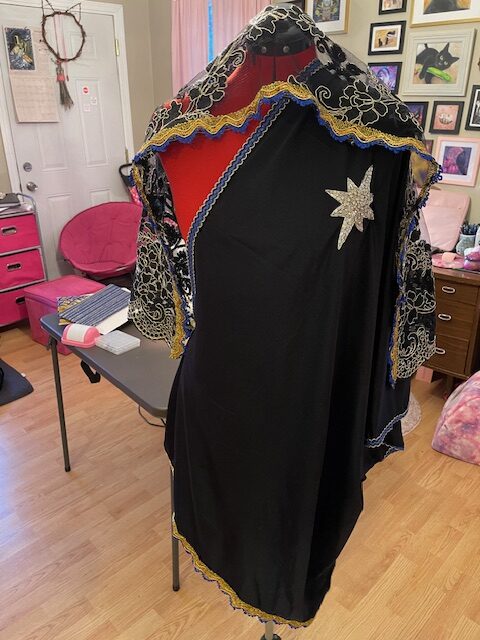
I was at Kalahari for a few days before the new moon because my husband’s job sent him to a conference there, meaning I got a free mini-vacation. I used this as an opportunity to prepare for my journey across the River Huber. I essentially spent three days mentally collecting water-based imagery and physical sensations to use during the ritual experience while meditating in the lazy river/wave pool/hot tub bar. For the first time, I really figured out how to use alcohol for entheogenic purposes – it’s actually really great for finding the sacred within the profane if you don’t over do it. I try not to drink too much nowadays after the whole breast cancer thing, but when in Rome! I sort-of turned my free mini-vacation into my own little private spiritual retreat (all those fake shamans who run those expensive “spiritual retreat” things would hate me!), which culminated with doing the actual rituals after we got home.
As far as the ritual itself, it was such an intense, emotional, and beautiful experience. I was literally trembling as I put on my black garment, and again as I crossed over the river. What struck me the most was that traveling to the underworld felt in no way scary to me. I was overcome with a profound sense of peace, love, and awe. I got this feeling like everything was just perfect and as it should be, and that as long as I didn’t try to fight it everything would be just fine. The underworld isn’t something to fear. Ereshkigal is often portrayed as “scary” and “cold,” but believe that is simply the human fear of the unknown being projected upon her. There is no escaping death, but at least She is there to care for you when you do get there. I got a sense that she is more nurturing and loving, if misunderstood, than she is often given credit for. I’m sure I’ll get a clearer sense once I proceed through the gates and meet her face-to-face.
The rituals in the descent section are meant to be performed three months apart, so I won’t be proceeding through the gates until April’s new moon. I am planning on working through the rituals from Samuel’s other book, The Red Shepherd during the months that I’m not actively working on Rod and Ring.
Since beginning my descent, I have set up a shrine to Ereshkigal. I’ve also moved Geshtinanna’s statue to Ereshkigal’s shrine for the time being, as this is the time of year when Geshtinanna is in the underworld.
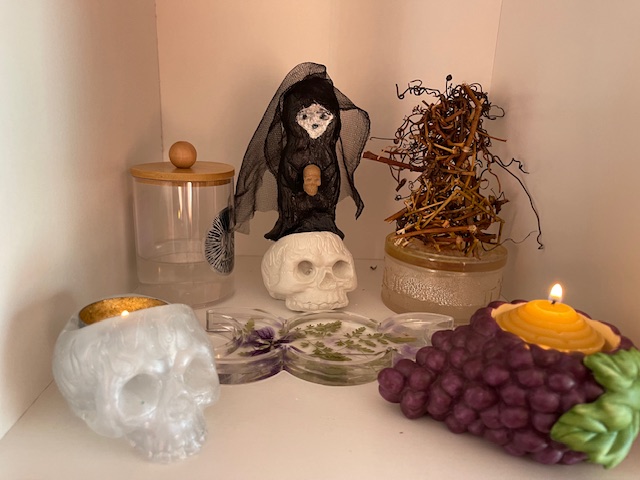
I’ve also started veiling as a way of symbolically reminding myself of my current place in the underworld, and that I belong to Ereshkigal just as much as I belong to Inanna. I’ve been wearing lacy headscarves to do this, like those triangle ones that were popular in the early 2000s. It’s a subtle enough style that it doesn’t draw too much attention, but is still true to what I believe the gods want of me. When I want to wear a different hat or hair accessory, I also consecrate it in the same way as the scarves/veils so they can be used in the same way. I’m using mainly lacy black scarves because they kind of remind me of a less conspicuous version of Victorian mourning veils. I’m planning on continuing to do this until I depart the underworld and have left my clay replacement.
Apparently veiling is already a thing in the pagan community, though I haven’t seen anyone say they’re doing it for quite the same reason. I don’t think I’ve heard of any other Mesopotamian polytheists doing it for any reason, though I haven’t spent a whole lot of time researching the subject.
Dumuzid – And My December Rituals
In December I finished the second section of the Rod and Ring initiatory journey. For the main ritual I met Dumuzi/Dumuzid (I see both spellings equally when reading about Sumerian religion, so I’m not sure which is actually the preferred rendering of his name – so far I haven’t gotten any sort of sense that He prefers one or the other like I did with Amageshtin/Geshtinanna).
As with the Geshtinanna, I was already familiar with Dumuzi before meeting him in this ritual. Aside from Inanna Herself, Dumuzi and Ninshubur are the deities I most revere (I only began working with Geshtinanna in the last several months).
To be honest, I was a bit hesitant to start worshiping Dumuzi to begin with because I wasn’t all that interested in having male deities. Which is also part of why I was never really interested in learning about Wicca when I started learning about paganism and witchcraft. I’m sure there’s some psychological reasons in there that I need to uncover and deal with through shadow work, but I digress.
To enhance the experience with Dumuzi, I also started reading Samuel’s newest book, The Red Shepherd right before the last new moon. I expanded on the rituals of thanksgiving for the 3rd, 4th, 5th, and 6th nights of the Rod and Ring initiation by also incorporating the liturgy from the Red Shepherd and extending the ritual activity by 2 days to make room for all 6 liturgical texts.
There was one final ritual for this part of Rod and Ring to be done on the full moon, so I did that on the 26th. I skipped doing the ritual from another book I’m going through, Evil Speech Stand Aside, last month, and I’ll just start doing them on months when I don’t have another full moon ritual to do to make it last longer, rather than doing a bunch of different things on one night.
I also did the Sheepfold rite from the Red Shepherd already, and plan to do the rest of the rites throughout the year. I’ll write more about those later. I’m not actually going by the Babylonian calendar to schedule these like the book suggested since the agricultural cycle of the US is different from that of Mesopotamia, and my lifestyle isn’t really based on the agricultural cycle anyway as a suburban woman in 2024. The next section of Rod and Ring skips some months, so I’ll probably start doing the Red Shepherd rites around the new moon of months that I don’t do Rod and Ring activities.
I did something different for my artwork offering this month. I got a set of watercolor pencils for Christmas, so I wanted to experiment with those. I have no idea what I’m doing with them, but I suppose that’s also the case with most things…
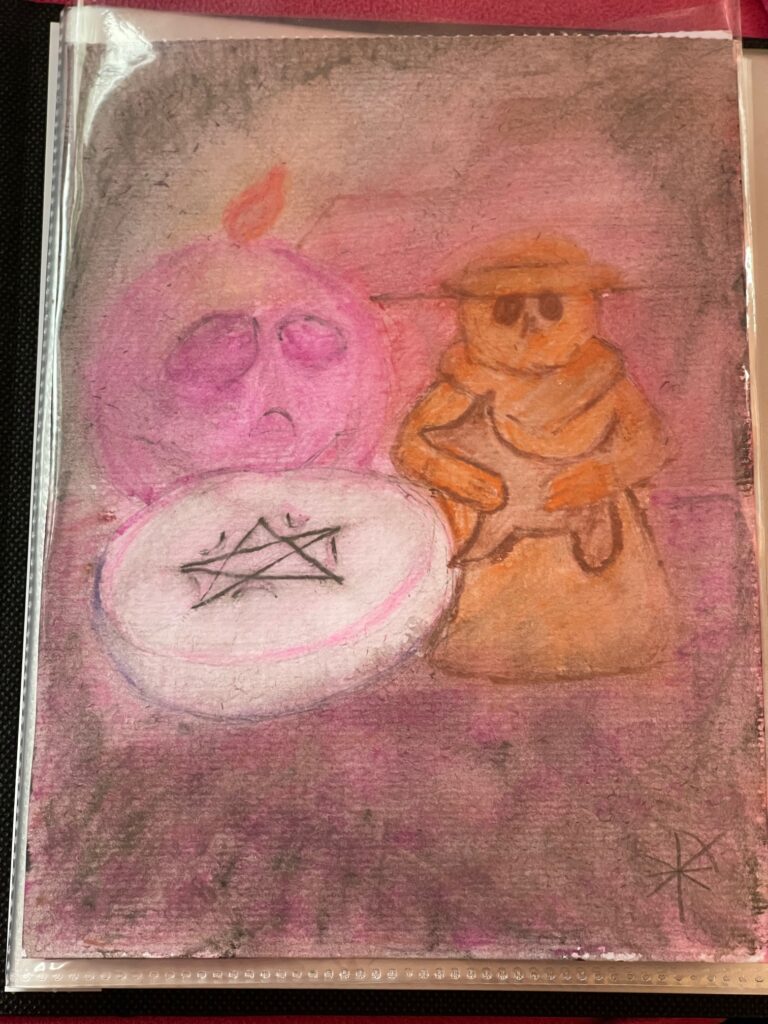
The first one is a painting of my statue of Dumuzi (which I based on an ancient figurine of a shepherd found in Girsu/Tell Telloh. The original probably wasn’t meant to be Dumuzi, but I am just so amused by how that particular statue looks, I had to recreate it), along with my skull candle holder and selenite plate. I just thought it looked nice on my altar during the rituals, so I made the painting to commemorate the ritual itself in addition to the deity. These items could also represent earth and the underworld.
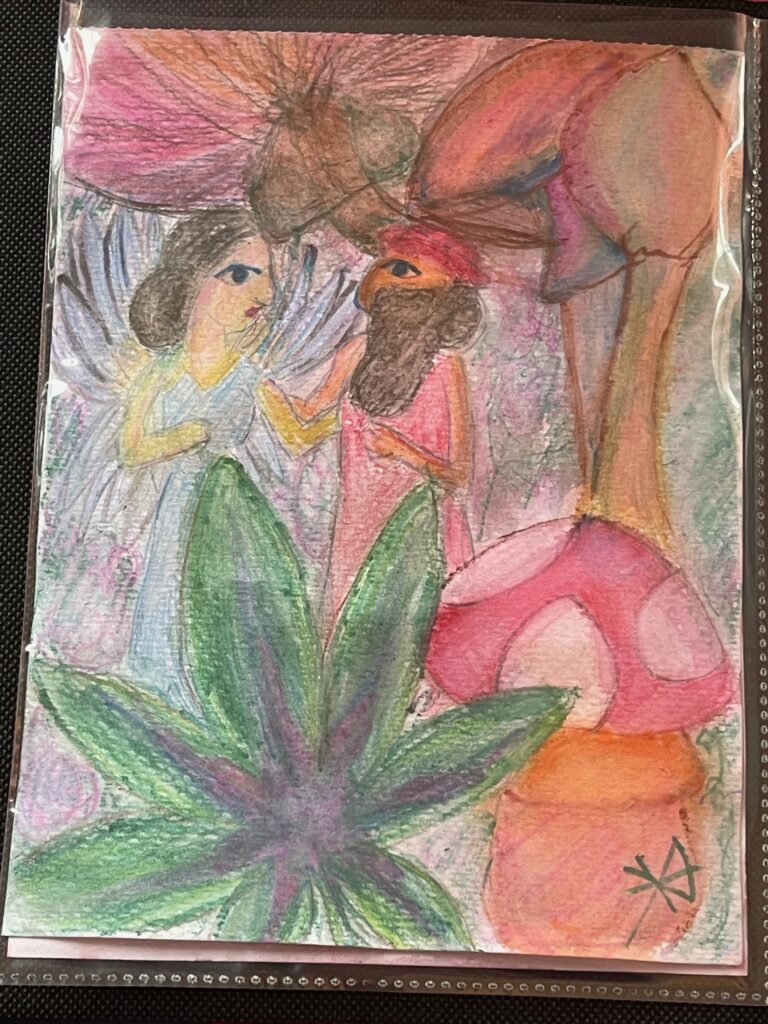
I also made a rendition of Inanna and Dumuzi, based on a relief carving depicting their marriage. I have no idea why I interpreted it in this way…
For Yule/winter solstice, I just did a simple Yule Log ritual and gave Inanna a special gift/offering. I don’t know that the Sumerians actually had a celebration for winter solstice, but I’ve been adapting different holidays and celebrations to fit my own religious practices. I used a small bit of apple wood for my yule log. It came from my apple tree that was destroyed in a snowstorm a few years ago. We cut down the remains of the tree but left the stump. The tree is regrowing now, and the wood I used was from the regrowth, symbolizing a time of rebirth and renewal.
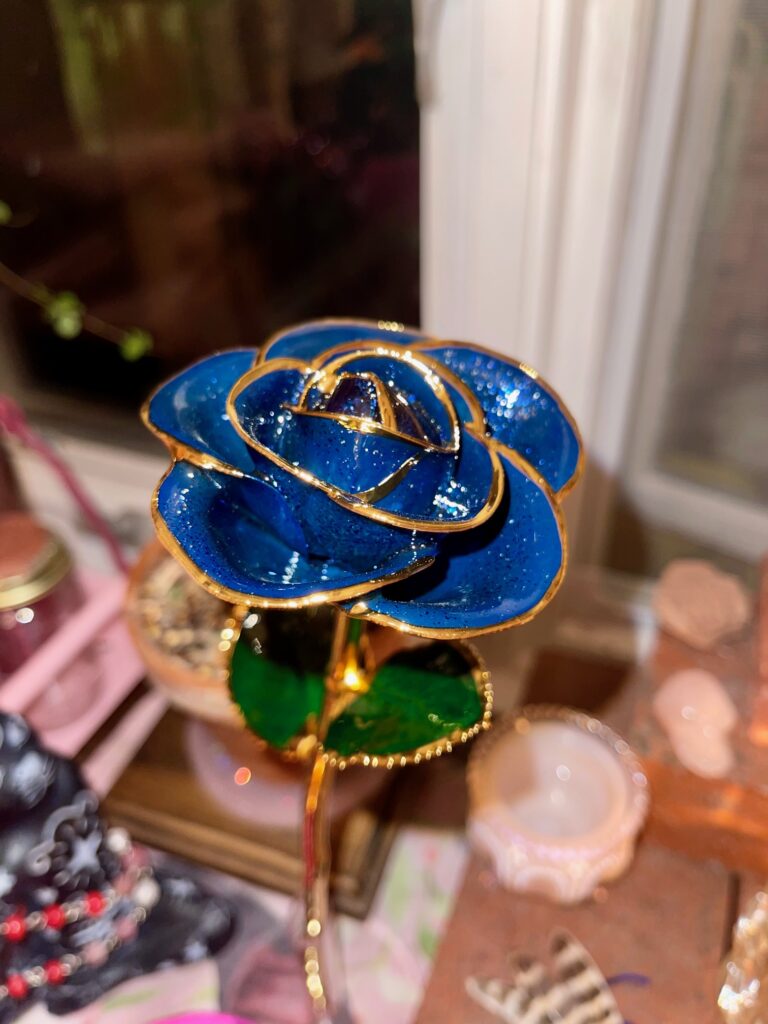
I like to give Inanna offerings of fresh roses from my garden throughout the growing season and was sad that I won’t be able to grow any for several months, so I got Her a gold dipped rose (which is a product I only knew about from listening to Howard Stern, so I hope She isn’t too offended! lol). I picked a sparkly blue one that reminds me of lapis lazuli and the night sky.
On Christmas, I decided it would be most appropriate to honor Dumuzi. I was already working with him a lot in December through the Rod and Ring initiatory rituals. And of all my deities, he is most similar to the Christian one, being a shepherd god and male. I gave him a nice offering of cheese on Christmas day. It was a simple and quick ritual.
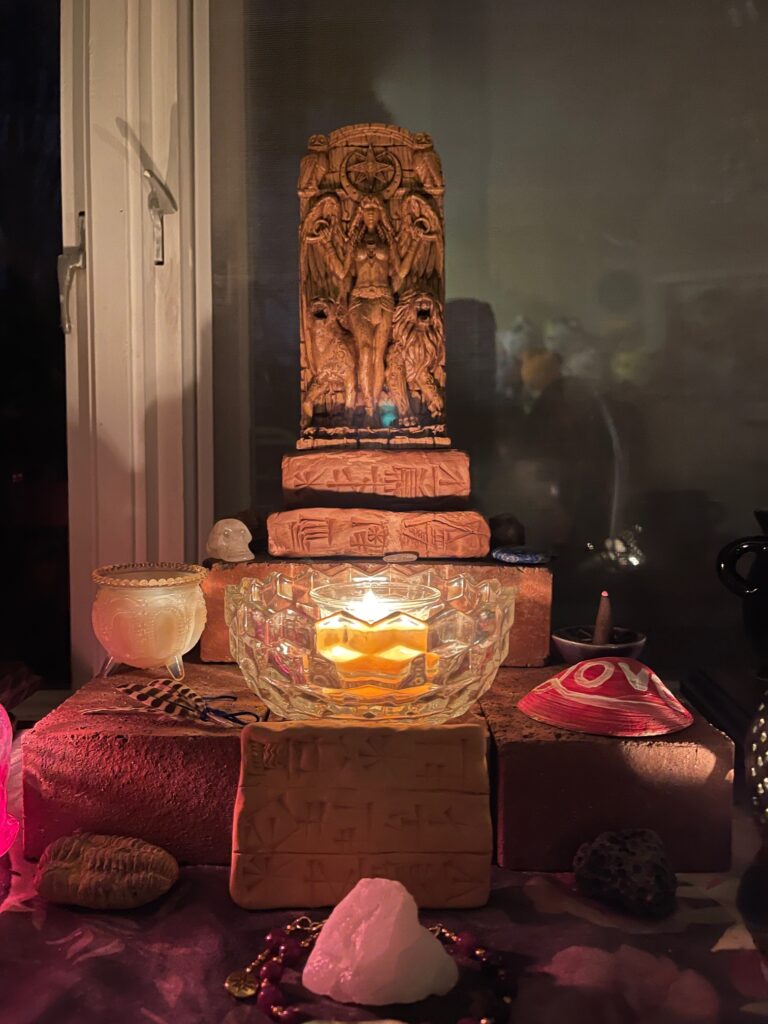
Back in November, did something similar, but a little bit more involved, to adapt Thanksgiving. I did a feast for all of my deities with offerings of things that they enjoy (like cheese for Dumuzi, dates for Inanna, etc.) right after doing a ritual to rededicate my temple to Inanna. I had recently thought of a name for my personal temple, E Ama Piring, Temple of the Mother Lioness, and I made a brick with the name inscribed in cuneiform to add to the dais, so I thought that improvement deserved a re-dedication ceremony (I hadn’t yet read ahead enough in Rod and Ring to know that I will be doing a temple dedication as part of my initiatory journey anyway, but that’s okay. That’s still months away and I’m sure I will have made plenty more changes by then).
Geshtinanna: The Grapevine of Heaven
For this month’s ritual for the Rod and Ring initiatory journey, I met with the goddess Geshtinanna. I was already somewhat familiar with her and have recently incorporated her into my regular practice, so it was a somewhat different experience from the previous months were I met deities with whom I was less familiar.
Since Geshtinanna’s energy was already a bit familiar to me, it felt sort of like meeting up with an existing friend, whereas previous month’s rituals had me meeting new deities for practically the first time. Geshtinanna, or Amageshtin as I prefer to call her in ritual, has a very motherly nurturing type of energy that is instantly recognizable after working with her for the last couple of months or so.

I made Her a painting, which I based a little bit on the 9 of Pentacles tarot card. That card always reminds me of Her when it comes up, particularly in the Ethereal Visions deck (I have the Luna edition, though I think that card is the same in both versions).
I anticipate that next month’s ritual with Dumuzi will feel similar, as I am even more familiar with Him than I was with Geshtinanna. I’ve also started reading Samuel David’s newest book The Red Shepherd in preparation for my ritual meeting with Dumuzi.
I’ve also started the series of rituals for the Seven Who Decree Fate from the book Evil Speech Stand Aside by Vanessa Kindell, in which the book instructs the ritualist to perform on the night of the full moon for seven months. For this first month, I connected with Nanna, whom I have already been working with every month the night before performing the main Rod and Ring rituals. At least thus far, I’ve found that I don’t connect with the rituals from this book as deeply as I do with the ones from Rod and Ring. I’m not quite sure what the problem is, but I’m going to keep working at it. If nothing else, it will help me to become more familiar with the Seven Who Decree.
My Introduction to Ningal

As I mentioned in a previous post, this month I did the Rod and Ring ritual for Ningal. I did have a brief experience with this goddess during the previous full moon before this new moon ritual.
The previous full moon, I also felt a connection to Ningal during ritual work. This was kind of strange to me, since I didn’t intend to connect with her. I was expecting to feel a connection to Nanna as I gazed at the moon, and maybe Marduk, as Jupiter was visible as well. (He keeps kind of showing up, but I don’t quite know how to work with him or if I even want to tbh.) I wasn’t doing a ritual for any specific purpose, just some light trance work to see what came through.
At this point, while gazing upon the full moon, I got the impression of Ningal kind of introducing herself, and that she wanted to be acknowledged as a deity of the moon in her own right, not just as the consort of Nanna. Understandable. Women are too often cast aside in the shadows of their male counterparts. Deities are apparently not immune to this. While Ningal is a loving mother and wife, she is also much more than that, and I think she wants her worshipers/Mesopotamian polytheists in general to acknowledge that. At least that’s the impression I got. And perhaps that the full moon is when she should be acknowledged (while Nanna, at least in this section of Rod and Ring, is acknowledged at the dark moon. Not sure if the later sections are the same, I haven’t read ahead).
At this point, I had forgotten that my next step in the Rod and Ring journey was with Ningal. I had it in my mind that Geshtinanna was next for some reason. But during this full moon experience, I got the impression that no, Ningal would be seeing me at the new moon. I double checked the book the next day, and sure enough, Ningal was, in fact, next.
During her ritual for Rod and Ring, I got similar impressions of her, and I think I felt a deeper connection to her than I did to some of the other deities that I’ve encountered in this initiatory journey thus far. I also got the impression that I should be honoring her in some way as part of my regular practice, particularly at the full moon as a moon goddess. Though she is the consort of the moon god Nanna, I don’t recall actually reading anything from scholarly sources that she was actually regarded as an astral deity the way Nanna, Inanna, and Utu are. I think I recall seeing random neopagan type sources refer to her as a moon goddess however, so maybe other people have had similar personal gnosis experiences as well, though you have to be careful with that sort of thing since a lot of neopagan websites/books just straight up make things up, especially the ones that just list a bunch of deities from completely different pantheons as simple random correspondences. So disrespectful, both to the deities and to the entire cultures to which they originally belonged.
I also got a sort of mental image of doing some kind of ritual honoring her over the ocean, perhaps on a boat or near the coast, with a particular focus on the tides. If we regard her as a moon goddess, this makes sense. Ningal is also the daughter of Enki, who is associated with water. The natural forces of water combined with the influence of the moon results in the tides, so I think it would be apt to regard her as a metaphysical embodiment of tides. The gods are essentially personifications of natural phenomenon and aspects of human experiences anyway. Traditionally, she is associated with reed marshes, a type of environment joining water and earth, not the ocean, however.
After making that connection, I did, however, find one small bit of evidence linking Ningal to the full moon and to tides. Last week, I read the book Evil Speech Stand Aside: Ancient Mesopotamian Ishib Magic for the Modern Magician by Vanessa Kindell (I haven’t tried all the rituals from that book yet). At the end of the book, the author listed some of the Mesopotamian deities along with some of their qualities. Ningal was described as a goddess of the reeds, the tides, and the full moon. The book didn’t cite where this information came from (historical source, vs unverified personal gnosis, vs random non-scholarly source, etc), but it is evidence that at least one other person who worships the Mesopotamian gods has made a similar connection.
A side note on unverified personal gnosis: I think the gods give different people different information because they just think its funny to watch humans argue over trivial shit. And it kind of is. At least that’s how I interpret it. Aside from cases of people just making things up.
I wasn’t really able to connect with Ningal this past full moon. I don’t know if it was some kind of personal block, or the fact that it was also a lunar eclipse that day. I don’t know enough about the effects of astrological phenomena on such things to know for sure, but it felt like it was blocking a connection from being made or something, even though the eclipse was earlier in the day. Or it may have been I was just too distracted/focused on other things at the time. It happens. There will be plenty more full moons to experiment with.
Lately I’ve also kind of been associating her with the Queen of Cups tarot card whenever that card comes up in a reading. I know Mesopotamian mythology doesn’t completely lend itself to the symbolism of tarot, but certain deities tend to show up regularly in my readings lately. I haven’t even been using my Babylonian deck much lately, but they still show up!